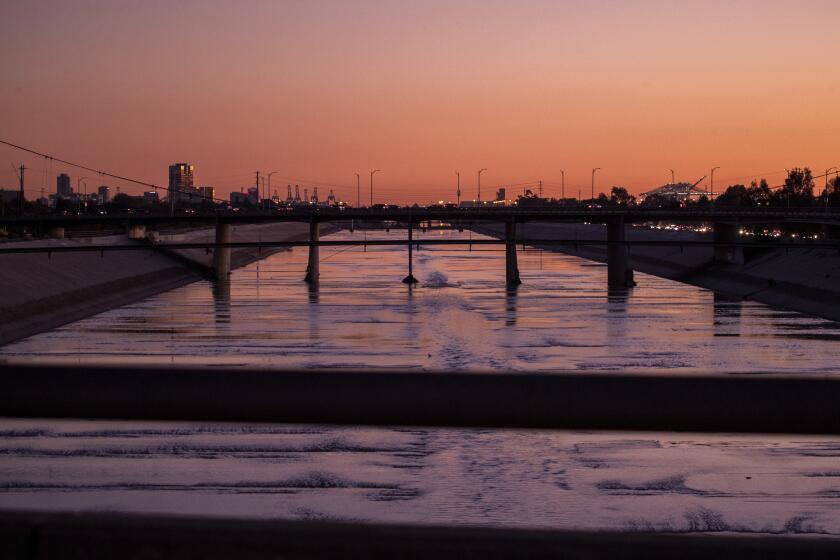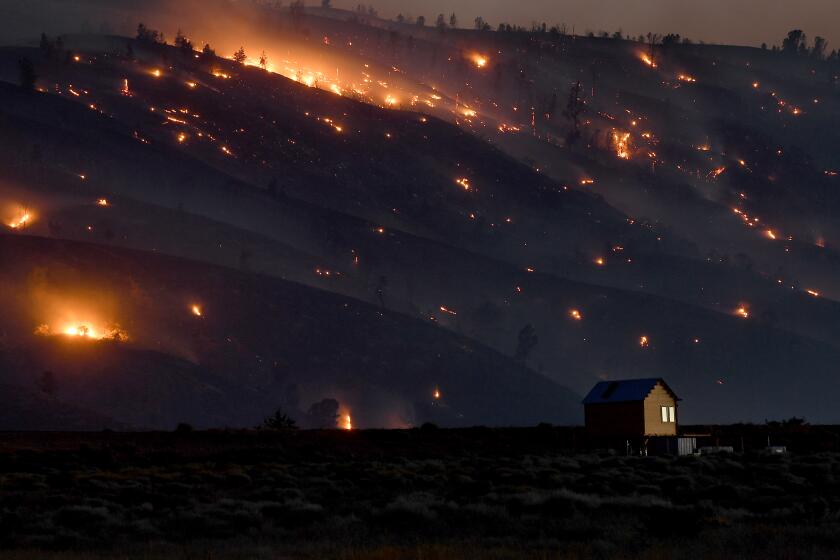
- Share via
A first-of-its-kind report has estimated that Los Angeles County must invest billions of dollars through 2040 to protect residents from worsening climate hazards, including extreme heat, increasing precipitation, worsening wildfires, rising sea levels and climate-induced public health threats.
The report, published this week by the nonprofit Center for Climate Integrity, identified 14 different climate adaptation measures that authors calculated would cost L.A. taxpayers at least $12.5 billion over the next 15 years, or approximately $780 million per year. The vast majority of those costs — more than $9 billion — will be incurred by local municipal governments, including the cities of Los Angeles, Long Beach and Santa Clarita, the report said.
“These numbers don’t include the costs of recovering from disasters — from extreme weather events that knock out power or damage infrastructure or do all the kinds of things they do,” said Richard Wiles, president of the Center for Climate Integrity. “So it’s a very conservative estimate, and yet it’s a really big number.”
Aggressive and impactful reporting on climate change, the environment, health and science.
Wiles said the costs for L.A. County are nearly as high as for the entire state of Pennsylvania, which faces about $15 billion in climate adaptation costs over roughly the same period.
“This is a big number, but this is going to happen,” he said. “These costs will be incurred at some point, and it’s just much better to pay now than it is to pay later. I can’t emphasize that enough.”
The most expensive adaptation categories are related to precipitation and heat, including an estimated $4.3 billion for improved stormwater management, $2.5 billion for cool pavement investments and $1.4 billion for tree canopies to combat urban heat islands, the report found. Other costs include wildfire mitigation; coastal defense and infrastructure protection; building upgrades for cooling and air conditioning; and responses to vector-borne diseases such as West Nile virus.
County officials said the findings weren’t surprising and agreed that they may even be conservative given the scale of the threats.
“The impacts of climate have become more and more visible over the past few years in particular,” said Rita Kampalath, L.A. County’s chief sustainability officer. “We know that we’re facing really, really huge needs in terms of how we prepare our communities to face those, and to be resilient in the face of increased climate impacts. It’s only going to increase from here.”
Stormwater capture in particular has been on the minds of many Angelenos this winter as record-breaking rainfall pounded the region. A monster storm in February saw the Los Angeles River roar to life and funnel millions of gallons into the Pacific Ocean.
But the river — which was encased in concrete nearly a hundred years ago — and other local flood channels will be no match for climate change-enhanced storms of the future. Though the long-term trend in the West is toward hotter and drier conditions, Los Angeles will still see bouts of severe storms and extreme wet years that will increase flood risk significantly, according to the state’s fourth climate change assessment.
To mitigate these impacts, the county must expand its stormwater drainage infrastructure by installing bioswales, porous pavement and other opportunities for stormwater to seep into the ground, the report found. It noted that these “green infrastructure” upgrades are the least expensive option to cope with extreme rainfall events, as opposed to increasing the size and scale of hard infrastructure such as drain pipes.
Capturing rainfall is only one part of the L.A. River’s job. It is also a flood control channel that is critical to protecting lives and properties when stormwaters surge.
The county is making progress on this work through its Safe Clean Water Program, passed by voters as Measure W in 2018, Kampalath said. The program allocates about $280 million annually to stormwater capture projects, although recent reports have found that progress to date has been slow.
“While it is a big need, I do actually feel like the county has been investing, and our residents and voters in particular have shown that this is a high priority,” she said. “We’re not as far as we would like to be — it’s hard to say that about much of anything when it comes to climate — but I do think that we have resources available to try to address some of these needs.”
Meanwhile, extreme heat continues to pose a significant threat to L.A. County residents, and it is predicted to only get worse in the years and decades ahead. The region is expected to experience an average of 48.5 days above 90 degrees per year between 2024 and 2040, the report says. That’s about 12.5 more hot days per year than communities experienced between 1994 and 2013.
Some of the best methods to combat the dangers of rising heat include installing cool pavements, expanding urban green space, painting railway tracks with reflective paint to keep them at operable temperatures, and upgrading cooling systems for public buildings such as schools, the report says. Converting public parking lots to cool pavements that reflect instead of absorb sunlight can also help lower ambient temperatures.
Heat is “the impact that affects communities of color the most, and people less able to adapt themselves and their personal lives,” Wiles said. He noted that some urban areas can simmer up to 20 degrees hotter than surrounding neighborhoods with heavy tree canopies.
“From a public health perspective, these types of adaptations are increasingly critical just to make neighborhoods livable,” he said.
The report comes at a moment when the state is facing a significant $37.9-billion budget deficit, which has prompted Gov. Gavin Newsom to slash $2.9 billion from California climate programs, delay an additional $1.9 billion and shift $1.8 billion to other funds.
Kampalath said it’s too soon to say whether those cuts will trickle down to L.A. County’s climate efforts, but that they could potentially affect funds officials were hoping to take advantage of through grants and other programs.
However, she noted that many of the county’s climate adaptation strategies can have multiple benefits, such as tree canopy programs that help combat heat and improve stormwater management simultaneously.
“As we’re looking at how to address these impacts, we do need to think about a multi-benefit approach, and what kind of strategies we can put in place that are really going to address a wide range of things — not only climate, but biodiversity and health impacts and the well-being of our communities as well,” she said.
When wildfire smoke and extreme heat combine, they create a “synergistic effect” or an additional burden on people’s health, researchers say.
Ultimately, funding for the projects outlined in the report will come from taxpayers, whether at the municipal, state or federal level, Wiles said. But he also hopes that oil and gas companies will be held accountable for their role in the worsening climate crisis, as fossil fuel emissions are by far the largest driver of global warming.
Last year, California filed a bombshell lawsuit against five of the largest oil and gas companies for their alleged “decades-long campaign of deception” about the risks posed by fossil fuels, which have forced the state to spend billions of dollars to address environmental-related damages. State Atty. Gen. Rob Bonta is seeking to create a nuisance abatement fund to finance climate mitigation and adaptation efforts, among other outcomes.
“Each and every community in Los Angeles County should consider bringing similar legal actions to hold climate polluters accountable and ensure that taxpayers aren’t left to pay the bill alone,” the report says.
Indeed, there are other climate hazards that will cost Angelenos billions in adaptation expenses over the next decade and a half, the report found.
They include an increase in vector-borne diseases such as West Nile virus as more mosquitoes are drawn to the area’s changing temperatures and precipitation patterns. About 500,000 new cases of the virus are expected in the county through 2040, which will cost an estimated $993 million to treat. Climate change will also lead to more pediatric asthma cases due to an increase in pollen, with about 160,000 new cases expected through 2040.
The county also needs about $680 million in road improvements as heat and rain contribute to more cracks, erosion and soft surfaces. A foot of sea level rise along the coast of L.A. County will require at least $576 million for berms, flood walls, bank stabilization and other infrastructure measures to prevent flooding and to avoid infrastructure damage by 2040.
Wildfires, already getting larger, faster and more frequent across California, will necessitate nearly $1 billion just to clear vegetation and other fuels from land around the county’s infrastructure, the report found. It noted that L.A. County will face an average of 36 more high-fire days through 2040 when compared to the 1994-to-2013 baseline.
The estimated $919-million wildfire cost does not account for fighting fires or repairing damage from blazes. The 2018 Woolsey fire racked up an estimated $3 billion to $5 billion in insured losses alone.
Wiles said the expenses outlined in the report won’t solve climate change but will help “hold things where they are today,” or least prevent the hazards from getting worse.
He said he hoped the report would help guide county officials as they face difficult choices about where, how and to what limited funds should be allocated. Investing in climate adaptations now can save money — and lives — later, he said.
“These costs are still coming,” Wiles said. “The next disaster will happen. This is just what it’s going to cost to prepare.”
Toward a more sustainable California
Get Boiling Point, our newsletter exploring climate change, energy and the environment, and become part of the conversation — and the solution.
You may occasionally receive promotional content from the Los Angeles Times.












